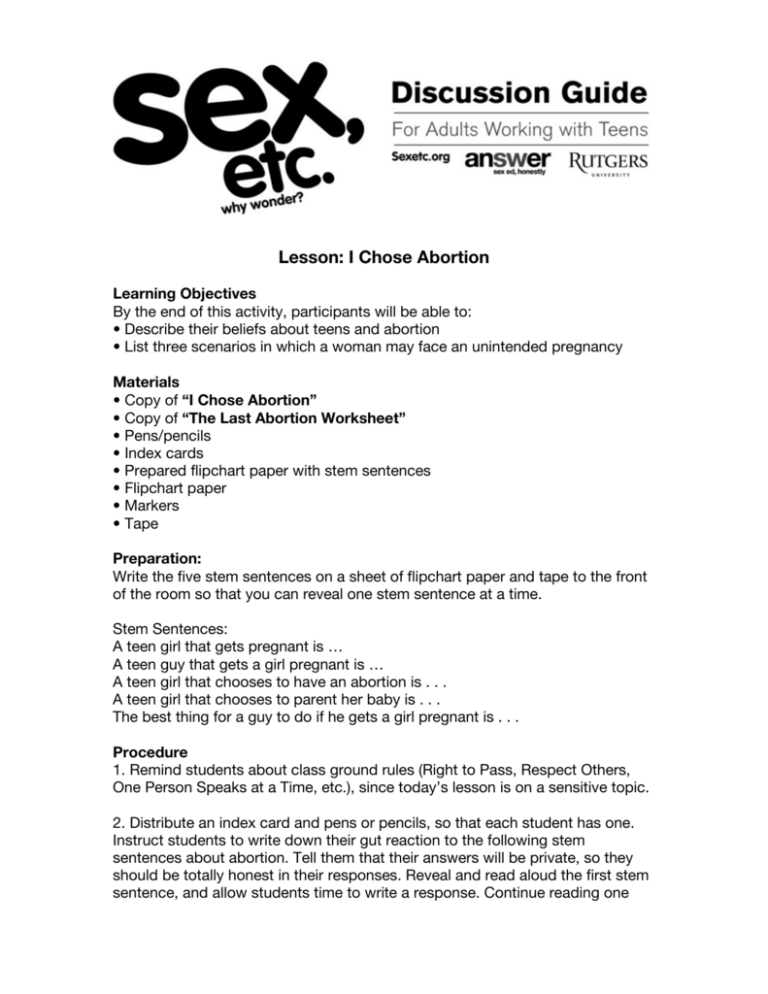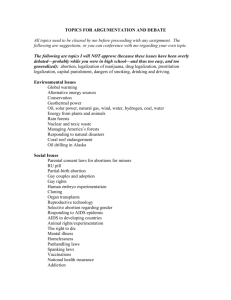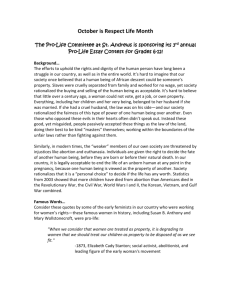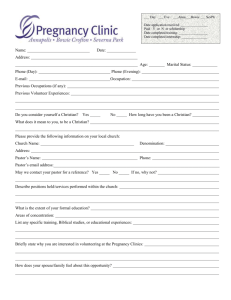
Lesson: I Chose Abortion
Learning Objectives
By the end of this activity, participants will be able to:
• Describe their beliefs about teens and abortion
• List three scenarios in which a woman may face an unintended pregnancy
Materials
• Copy of “I Chose Abortion”
• Copy of “The Last Abortion Worksheet”
• Pens/pencils
• Index cards
• Prepared flipchart paper with stem sentences
• Flipchart paper
• Markers
• Tape
Preparation:
Write the five stem sentences on a sheet of flipchart paper and tape to the front
of the room so that you can reveal one stem sentence at a time.
Stem Sentences:
A teen girl that gets pregnant is …
A teen guy that gets a girl pregnant is …
A teen girl that chooses to have an abortion is . . .
A teen girl that chooses to parent her baby is . . .
The best thing for a guy to do if he gets a girl pregnant is . . .
Procedure
1. Remind students about class ground rules (Right to Pass, Respect Others,
One Person Speaks at a Time, etc.), since today’s lesson is on a sensitive topic.
2. Distribute an index card and pens or pencils, so that each student has one.
Instruct students to write down their gut reaction to the following stem
sentences about abortion. Tell them that their answers will be private, so they
should be totally honest in their responses. Reveal and read aloud the first stem
sentence, and allow students time to write a response. Continue reading one
stem sentence at a time and allowing response time, until you have completed
all five. Then read them through again, one at a time, asking for volunteers to
share their responses. (Facilitator Note: The purpose of this activity is to briefly
assess the attitudes that your students already hold about abortion and to allow
the students to hear the variety of opinions in the group. This is not a time to
spark discussion or debate, but simply to listen and reflect.)
3. Distribute the article “I Chose Abortion” to students and read together with
your students. Guide discussion with the following questions:
• What are some reasons why teens might have sexual intercourse and not use
birth control?
• What do you think about the boyfriend’s role in this situation? Did he act
responsibly? Could he have done anything differently in your opinion? If so,
what?
• If the author was your friend and she told you she was pregnant and didn’t
know what to do, what advice would you give.
• How do you feel about parental notification and/or consent laws?
• What are some ways to prevent the need for abortion? How could parents
help? How could schools help?
4. Divide students into groups of four and distribute “The Last Abortion
Worksheet.” Read the directions aloud at the top of the worksheet and ask if
there are any questions about the directions. Allow groups ten minutes to
complete the worksheet and try to reach consensus. (Facilitator Note: Students
may initially resist sitting in judgment of other people and their decisions. Push
them to struggle with this activity, and invite them to share their feelings about
the activity at the end.)
5. Process the activity by asking students:
• How did it feel to complete this worksheet?
• Why was it difficult for some people?
• What factors did your group consider as you made your decisions?
• What can happen when someone else makes a personal, medical decision for
another person?
• What might happen if abortion became illegal in the U.S.?
• What might some possible consequences be?
6. Close the discussion by thanking students for their hard work on this difficult
topic and remind them that comprehensive sexuality
education can help teens prevent the need for abortions by preventing
pregnancy.
(Special thanks to Laurie Lowenstein for her review of this activity.)
Copyright © Answer, Rutgers University. All Rights Reserved.
The Last Abortion
Nora Gelperin, M.Ed.
Imagine that you are a Supreme Court Justice. Congress has just passed an amendment
making it illegal to have an abortion for any reason. The legislation was deemed unconstitutional
and you have just finished hearing arguments from both sides. You assume your fellow Justices
will vote in favor of this legislation even though two are abstaining. As a Supreme Court you have
been given a special privilege. The Justices are able to grant one woman the last safe, legal
abortion before the legislation becomes law. Below is the only information you have been given
about each woman who is seeking this last abortion. Your task is to discuss each case with your
fellow justices and try to come to a consensus about which woman you believe should receive the
last abortion and why.
1. A 14 year-old teenager who was sexually abused by a friend of the family. That abuse resulted
in her pregnancy.
2. A 39 year-old single mother of five children who is dependent on governmental programs to
help provide for her family. She is only able to work outside of the home part-time.
3. A 36 year-old woman who was recently diagnosed with breast cancer and requires immediate
chemotherapy in order to have a good chance of surviving the cancer.
4. A 23 year-old woman who was brutally raped by her ex-boyfriend. She had a restraining order
issued against him.
5. A 30 year-old woman whose pre-natal tests show gross fetal anomalies, meaning severe birth
defects.
6. A 34 year-old mother of three, whose marriage is on the brink of divorce due to her husband’s
severe depression, became pregnant as a result of sex she and her husband had on one of his
very infrequent “good days”. Her husband has told her that having another child would almost
certainly result in divorce given his mental health status.
7. A 22 year-old woman who was recently diagnosed with HIV. There is a chance that the baby will
be born HIV+ unless she can get AZT (the medicine that will help prevent the spread of HIV to her
baby).
8. An 18 year-old who is planning to go to college on full academic scholarship. The condom
broke that she and her boyfriend were using. She will lose her scholarship if she misses a
semester at school.
9. A 46 year-old woman who thought she was going through menopause when she did not get her
period. Her children are all grown and she is about to become a grandmother.
10. A 25 year-old woman with moderate developmental disabilities who lives in a group home. Her
long-term boyfriend lives there as well although the group home cannot provide housing for infants.





